microbio lecture 21 (food microbio)
1/65
There's no tags or description
Looks like no tags are added yet.
Name | Mastery | Learn | Test | Matching | Spaced |
|---|
No study sessions yet.
66 Terms
porphyra
____ → nori
made from red algae
seaweed are marine algae
spirulina
food additive
a spiral-shaped cyanobacteria that is used to add protein, vitamin B12 and minerals to foods
anaerobic fermentation
is used to process a wide variety of foods
acid fermentation
produces organic acid fermentation products, like lactic acid in cheese
alkaline fermentation
produces basic fermentation products, like ammonia in natto
ethanolic fermentation
produces ethanol and carbon dioxide like beer
food fermentation
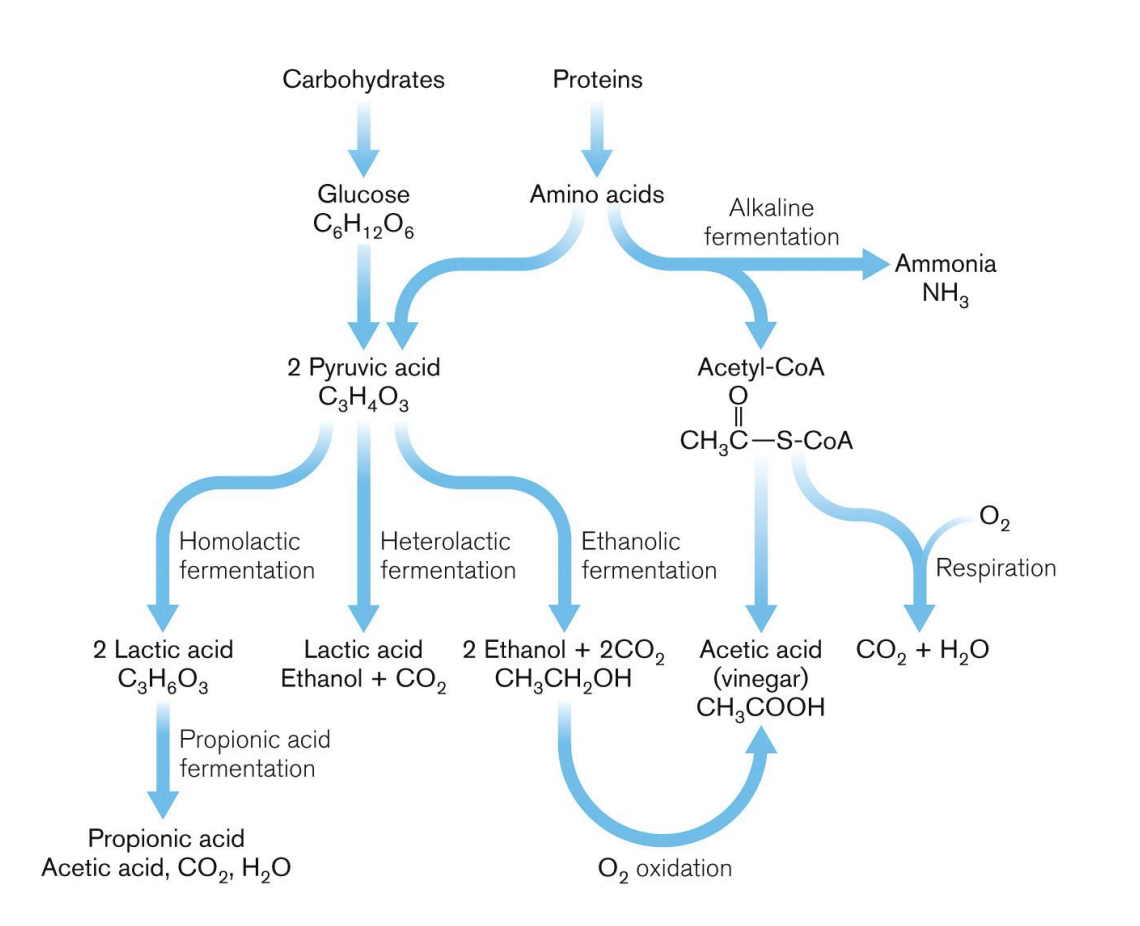
preservation, improved digestibility, tastes good
why do we ferment foods?
preservation
a reason why we ferment foods:
lactobacilli (and some other groups of bacteria) metabolism produces carboxylic acids, ammonia, and/or alcohol as waste products
these waste products increase food shelf life
improved digestibility
a reason why we ferment foods:
microbes break down molecules we cannot, increasing a food’s nutritional value
wild
how do we ferment foods?
home and small-scale fermentation relies on ___ microbes, microbes found naturally in association with the food or starter cultures
commercial fermentation use engineered microbial strains
acid fermentation
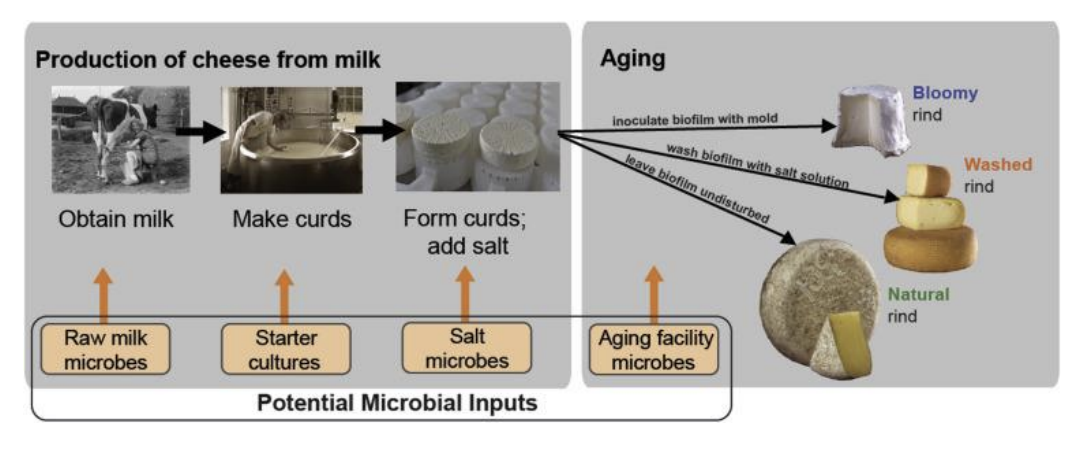
caseins, rennet
cheese production:
making cheese starts with making curds from milk
milk is acidic (~pH 6.6)
Lactobacillus and streptococcus ferment lactose to lactic acid, acidifying the milk
as milk acidifies, _____ (a hydrophobic protein) destabilize and begin to clump together
initial result is yogurt
_____ or another protease is added to continue breaking down casein OR heat is added to denature casein
soft cheeses, like cottage cheese do not have this added
denaturing caseins
acid and heat coagulation causes small clumps of caseins
ricotta, cottage, cream cheese
adding rennets = enzymatic coagulation which denatures caseine K to paracaseine K = larger hard clumps
swiss, muenster, cheddar
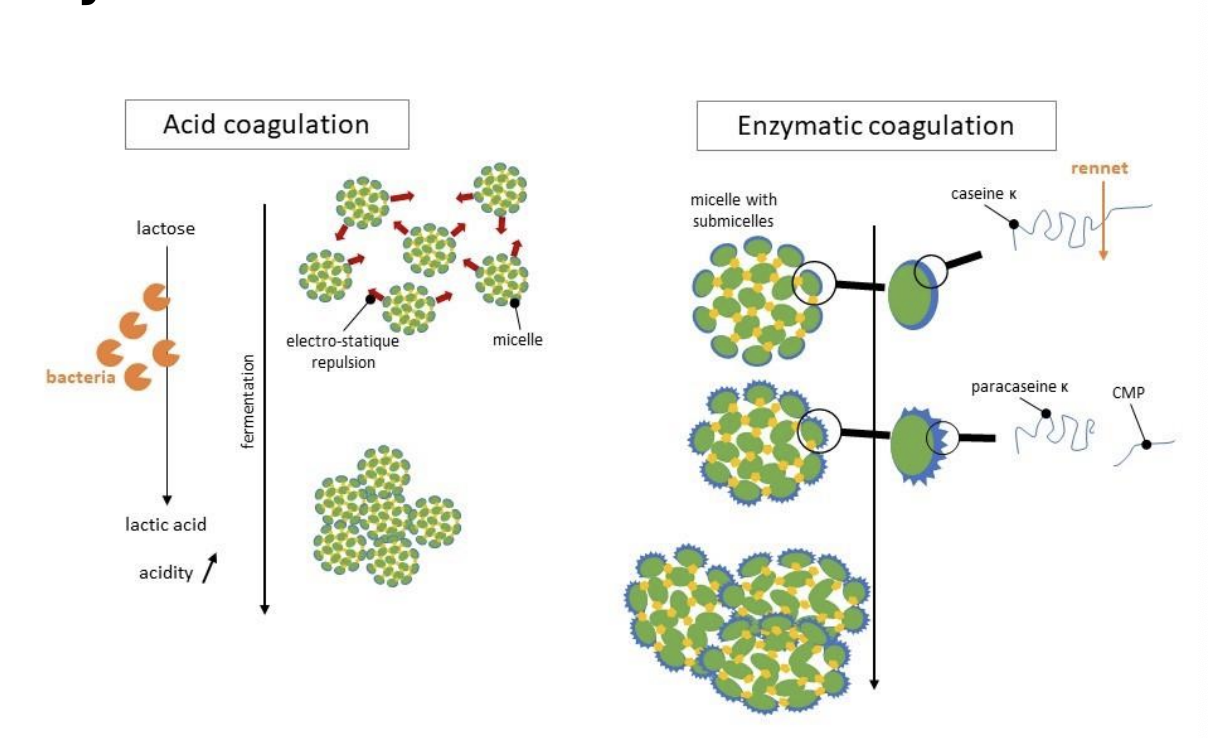
cheese production
ferment the milk
cheddar/cut the curd
shape the curd
brine/ripen
soft, semihard, hard, brined, mold-ripened
___ cheeses - high water content, no aging or ripening
___ cheeses - moderate water content, aged for several months
___ cheeses - low water content, aged for months or years
___ cheeses - salt is added
___ cheeses - mold spores are added
mesophilic culture
these cultures are used to make a variety of low temperature and fresh cheese. optimal growth temperature is from 86-93 F
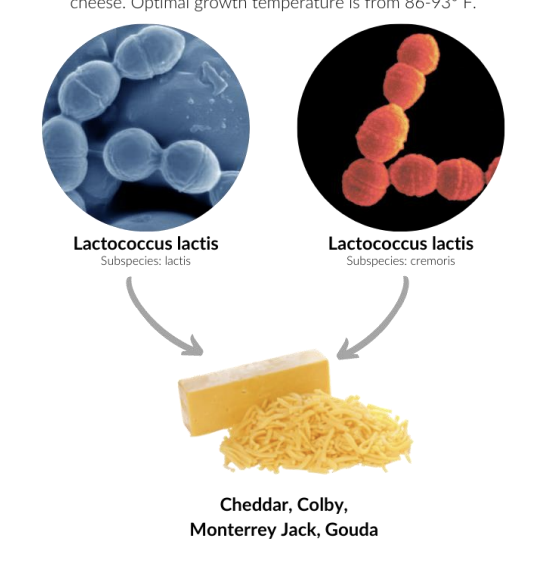
thermophilic culture
these cultures are used to make a variety of drier and longer aged cheese. optimal growth temperature is from 95-116 F
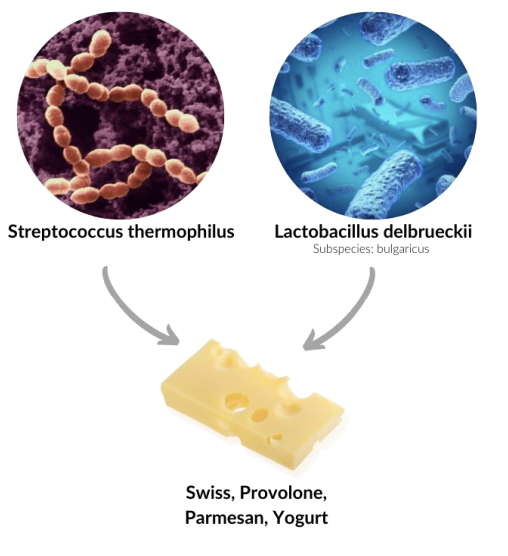
lactic acid, propionic acid
why does swiss cheese have holes?
sometimes, cheese goes through two rounds of fermentation
primary ____ ____ fermentation
lactobacillus ferments lactose to lactate (lactic acid)
secondary ____ _____ fermentation
Propionibacterium freudenreichii ferments lactate to propionate, producing CO2 as a biproduct
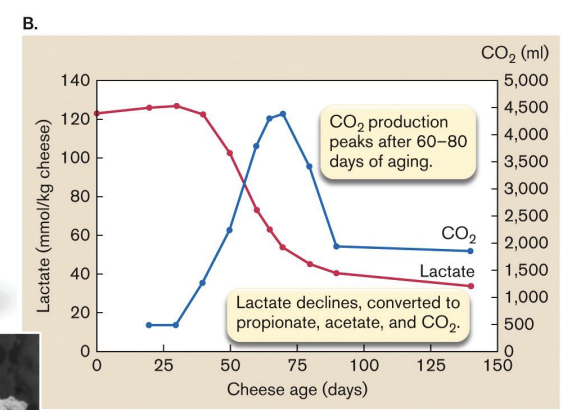
phytate
Soybeans are high in protein, but also have compounds that make them difficult to digest
____ chelates iron, decreasing intestinal absorption
Soybean lectins cause stomach upset
Soy protease inhibitors inhibit digestive enzymes that break down protein
Fermentation can decrease the concentration of these harmful compounds while keeping the protein content high
soy fermentation
A common bread mold, Rhizopus oligosporus, is used to produce tempeh
Rhizopus breaks soy proteins down into smaller peptides and amino acids that are easily digested
Lactic acid bacteria initially ferment soybeans while they are soaked overnight
This creates the condition for Rhizopus to flourish
cabbage fermentation
sauerkraut and kimchi
heterolactic fermentation by Leuconostoc mesenteroides
homolactic vs heterolactic fermentation

Yeast, lactic acid, oxygen
Cocoa bean fermentation:
Making chocolate from cocoa beans requires 3 successive fermentation steps, each using a different microbe
Cocoa pulp is initially fermented anaerobically by ____ (Candida, Kloeckera, and Caccharomyces)
This liquifies the pulp, consumes citric acid and sugars found naturally in the beans, and produces ethanol and acetate
As the pH increases (from 3.6 -> 4.2), ___ ___ bacteria (Lactobacillus plantarum) contribute to sugar fermentation
Finally, _____ is introduced to the system and acetic acid bacteria (Acetobacter) consume ethanol and acids, producing CO2
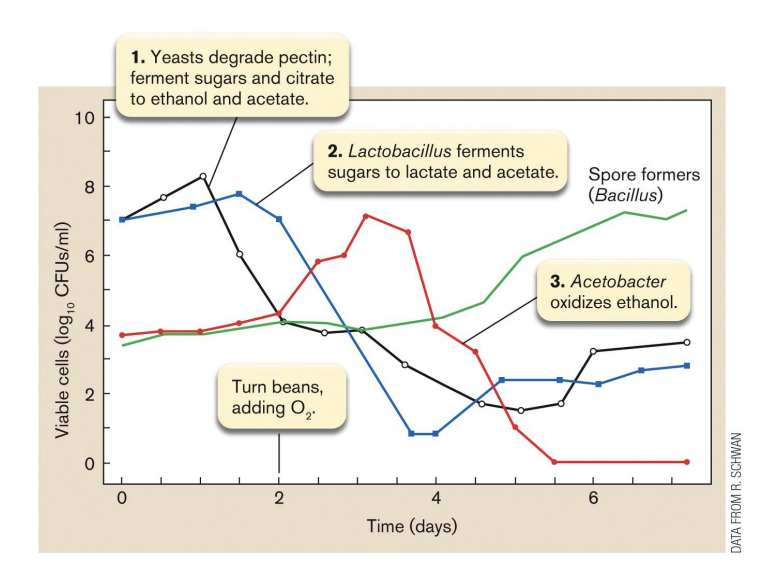
yeasts, lactate and acetate, ethanol
cocoa bean fermentation:
_____ degrade pectin; ferment sugars and citrate to ethanol and acetate
Lactobacillus ferments sugars to ____ and _____
acetobacter oxidizes _____
bacillus
• In contrast to lactic acid fermentation (and other acid fermentation methods), fermentation with ____ increases pH
aerobic bacteria that are pros at proteolysis and amino acid decomposition
natto
Soybeans are fermented using Bacillus natto to increase digestibility
In addition to producing ammonia (which is lost as gas), B. natto produce a stringy extracellular matrix called polyglutamate
pidan
Century eggs are duck eggs that have been treated with tea, lime (CaO), and sodium carbonate (Na2CO2 ) to raise pH and then fermented with Bacillus underground
yeast
Saccharomyces cerevisiae (____) ferments pyruvic acid to ethanol and carbon dioxide:
𝐶3𝐻4𝑂3 → 𝐶𝐻3𝐶𝐻2𝑂𝐻 + 𝐶𝑂2
This is the key to producing leavened bread and alcoholic vegetables
injera
Yeasted or leavened breads are produced by:
Introducing a starter yeast culture (baker’s yeast or sourdough starter) into the dough
Kneading to develop the gluten, which allows the air pockets to room
Waiting for the bread to rise as CO2 is produced
_____ is a bread that used prolonged fermentation
Teff (a high protein, gluten-free grain) cannot rise the way wheat can
Injera is produced by fermenting teff flour with Candida for 3 days
beer
produced by fermenting germinating barley with yeast (Saccharomyces cerevisiae)
wine
similar to beer production, but the starting food is fruit
Grapes (or other fruit) are fermented by yeast, most commonly Kloeckera and Hanseniaspora
Proteolytic enzymes, Oxidation, microbes
How food spoils:
Enzymatic processes
an animal’s own _____ _____ tenderize its flesh
Sugars in plants get converted to starch after harvest
Chemical reactions
_____ is a common reason for food spoilage – lipid oxidation makes food rancid
Microbial processes
_____ colonize foods and consume them – the metabolic products spoil food
water, carbohydrates
Why does meat and and fish spoil faster than fruits and veggies?
Their nutrient composition and water content differ
Low ____ content -> longer shelf life
More ______ -> fermentation, not putrefaction
Plant pathogens and commensal bacteria are not usually harmful to humans
food-borne pathogen sources

bacterial growth
keeping food safe relies of slowing or controlling ___ _____ and/or colonization
methods:
Chemical preservation with spices
Heat treatment via cooking
Fermentation
Dehydration and freeze-drying (no water = no microbial growth)
Refrigeration and freezing (slows microbial growth)
Acid treatment (adding citric acid to slow microbial growth)
Vacuum sealing (limits oxygen)
Pasteurization (short high heat treatment kills bacteria)
Chemical additives

bioprospecting
the search for organisms with potential commercial applications
The goal is to find microbes (or other organisms) that naturally produce a useful product
We then learn how the product is produced and scale up production
good microbial products
Genetically stable and able to be manipulated
Inexpensive to grow
Safe
Efficiently produce the desired product
Amenable to an easy harvest mechanism
Common species used to create microbial products include Escherichia coli, Bacillus subtilis, Candida utilis, and Aspergillus niger
microbial vitamins
Many essential vitamins are highly complex molecules
B12 is both very complex and important for red blood cell formation
We make most commercially available B12 using bacteria
b. thurinigenesis
____ ______ is the most commonly used biological pesticide worldwide
____ ______ produces Bt toxin, which is fatal to caterpillars
Bt toxin binds to the intestinal wall, lyses the epithelial cells, allowing normal gut bacteria to colonize the rest of the caterpillar body
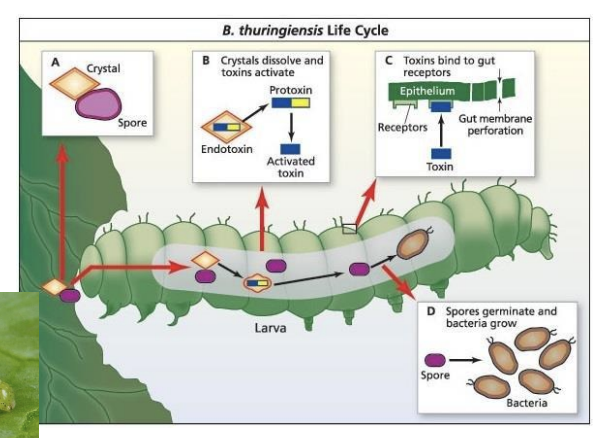
bioplastics
An ancient way of storing carbon
Similar to lipid droplets only solid at ambient temperature
Two major kinds
Polyhydroxybuturate (PHB)
Polyhydroxyalkanoate (PHA)
Produced by many different bacteria and archaea
Can be used to generate large amounts of biodegradeable plastic!
Technology has been in development for decade
bioremediation
the cleanup of oil or other pollutants by microorganisms
examples include cleanup of oil spills, pesticides, dechlorination, solid wastes, and sewage treatment
catabolizing
One of the ways microbes gain energy is by ______ molecules
they see “waste” products as “food”
Microbes have evolved to extract energy (in the form of electron transfer) from a diverse range of organic and inorganic molecules
This allows microbes to play key roles in the circular economy
anaerobic bioremediation
Chlorinated Solvents
Tetrachloroethene, trichloroethene, trichloroethane, and carbon tetrachloride
Hazardous and not easily degraded
Anaerobic degradation sequentially removes chloride ions

hydrocarbon decomposition
A variety of naturally occurring bacteria, fungi and green algae are able to oxidize hydrocarbons
Hydrocarbon-oxidizing bacteria develop on oil films and slicks
Hydrocarbon-oxidizing bacteria associate with oil droplets and concentrate at the oil water interface
The bacteria oxidize the oil to CO2
Studies of oil spills indicate that the bacteria increase in number 103 -106 times shortly after the spill
Under ideal conditions the microbes can oxidize ~80% of the nonvolatile components within 1 year
These microbes are good enough at their job that antimicrobial agents need to be added to gas storage tanks to prevent degradation of the fuel at oil-water interfaces
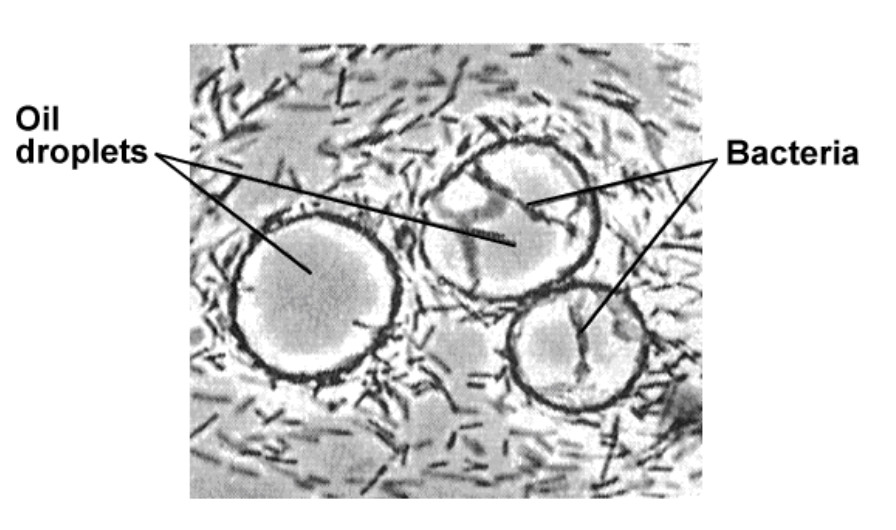
phosphates and nitrogens
hydrocarbon decomposition
The addition of nutrients like ______ and _____ to the spill area increases bioremediation rates
Although microbes are a considerable aid, big spills still require human efforts to ensure a timely cleanup
D. radiodurans
radioactive bioremediation:
A lethal level of radiation for humans is about 700 rads.
______ _______ can withstand 1.5 million rads
Exposure to high levels of ionizing or UV radiation lead to extensive DNA damage
In contrast to other bacteria, ___ _____ can repair its DNA
ddrA
How does D. radiodurans survive such high levels of radiation??
Using microarrays, Harris et al identified a single open reading frame whose expression was induced ~2-fold following treatment of D. radiodurans with ionizing radiation
Expression of RecA, another DNA repair protein, was only increased 1.5-fold under the same conditions
Deletion of this ORF (renamed ___) resulted in increased sensitivity to ionizing radiation
Deletion of_______ results in increased sensitivity to DNA damage
____ protects single stranded 3’ ends from endonuclease activity
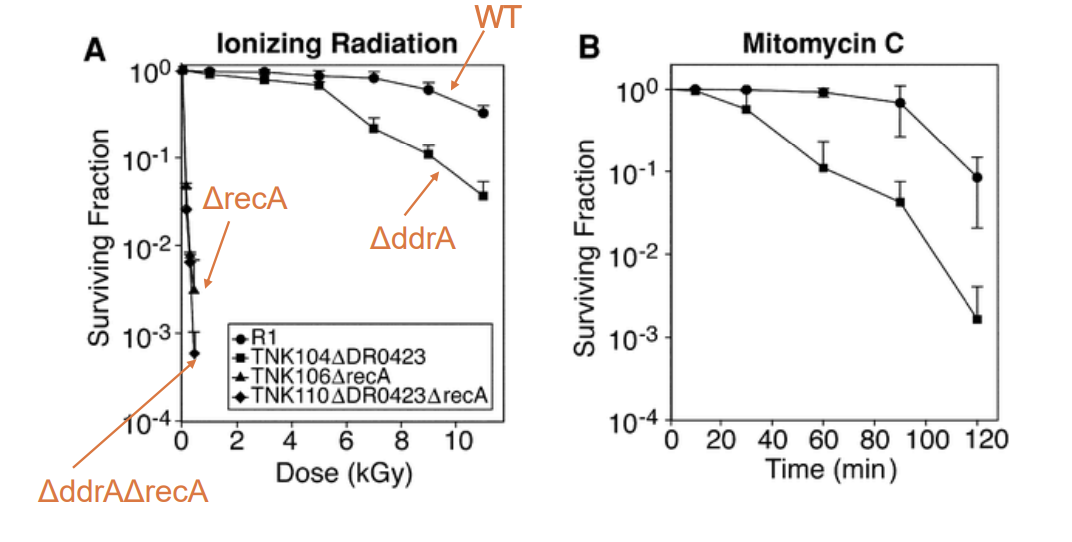
D. radiodurans for bioremediation
The mercuric reductase gene from E. coli has been cloned into D. radiodurans to detoxify the ionic mercury found in radioactive waste generated from nuclear weapons manufacture
This strain of D. radiodurans reduces Hg(II) to less toxic elemental mercury
The same lab has also been able to engineer D. radiodurans to detoxify toluene as well
poly
Ideonella sakaiensis breaks down ____(ethylene terephthalate), a component of plastics
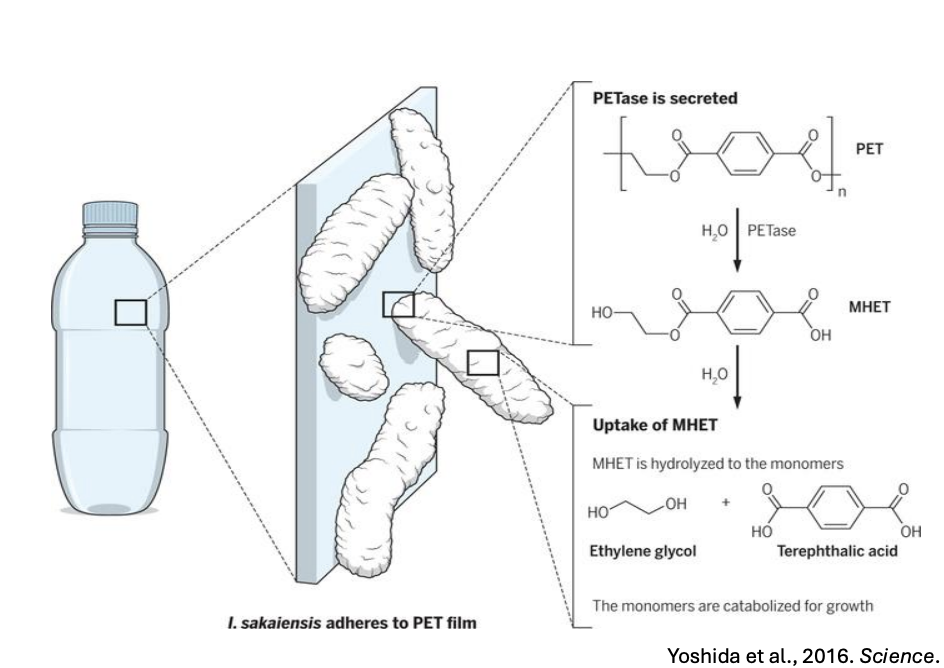
e-waste
Methylobacterium extorquens can be used to extract rare earth metals from e-waste
M. extorquens grows on and sequesters lanthanides and other rare metals
wastewater treatment
Wastewater is the liquid extracted from sewage and industrial sources
It contains both inorganic and organic components including pathogenic bacteria, phosphates, and trace metals
15,000 wastewater treatment plants exist in the US. Collectively they process 40 billion gal of wastewater a day
primary treatment of wastewater
consists of removal of solids by passing it through a series of screens and letting the effluent stand for several hours to let the solids settle to the bottom
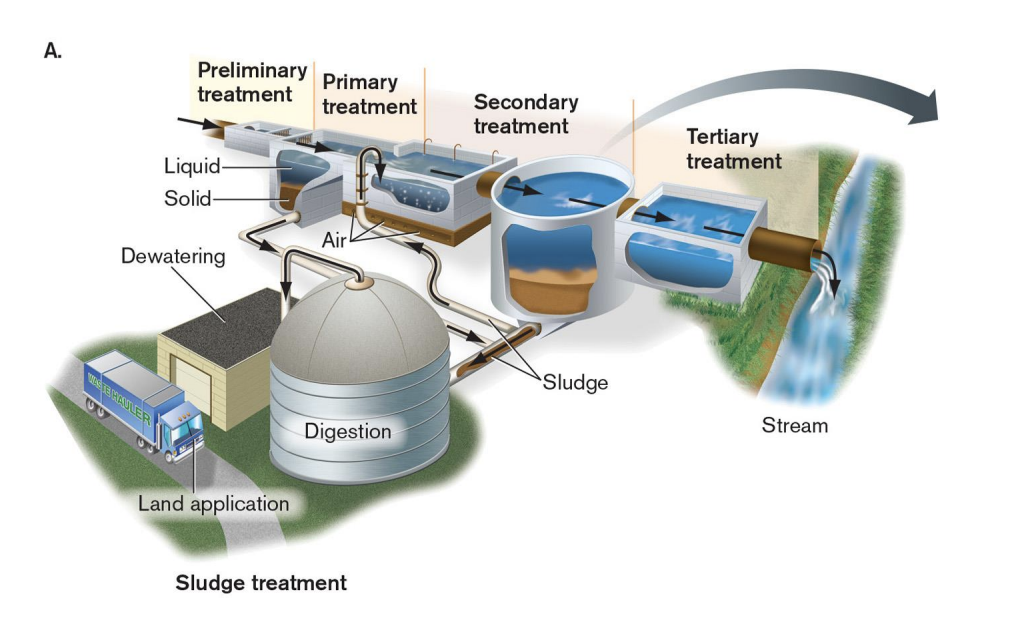
secondary treatment of wastewater
employs microbes to reduce the organic load of the wastewater to environmentally acceptable levels.
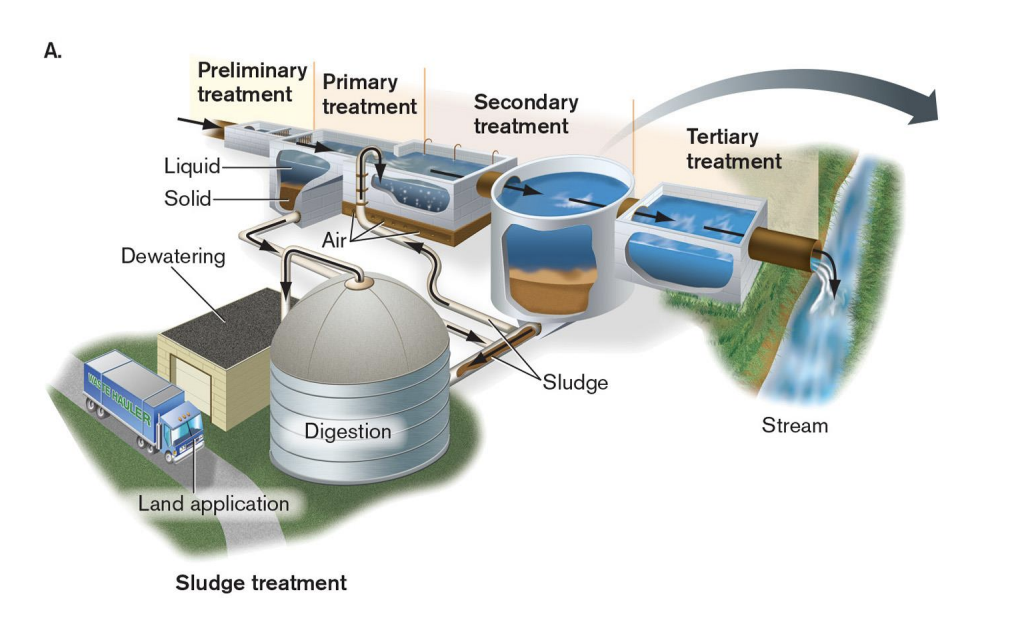
tertiary treatment of wastewater
uses chemical methods (precipitation, filtration, and chlorination) to remove inorganics like phosphate from wastewater (Very Expensive and not always done)
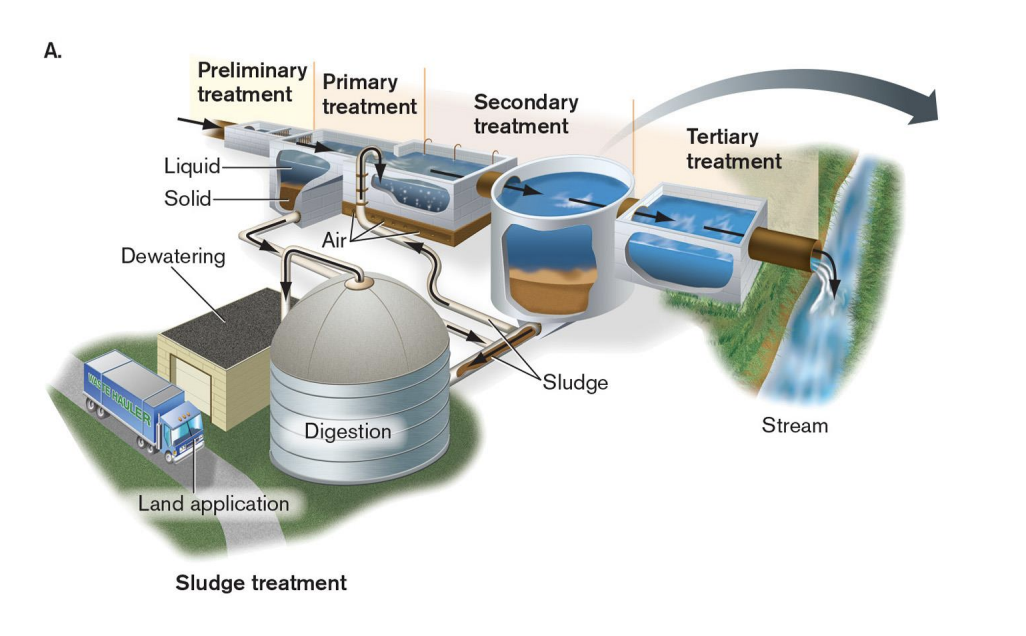
anoxic secondary treatment
A set of digestive and fermentative reactions carried out by a variety of bacterial and archaeal species
The efficiency is measured in terms of the percentage decrease in biological oxygen demand (BOD)
BOD refers to the amount of oxygen that would be consumed if all the organics in one liter of wastewater were oxidized by bacteria, archaea and protozoa
A good wastewater treatment plant removes 95% or more of the initial BOD
The degradation process takes place in “sludge digestors” or “bioreactors”
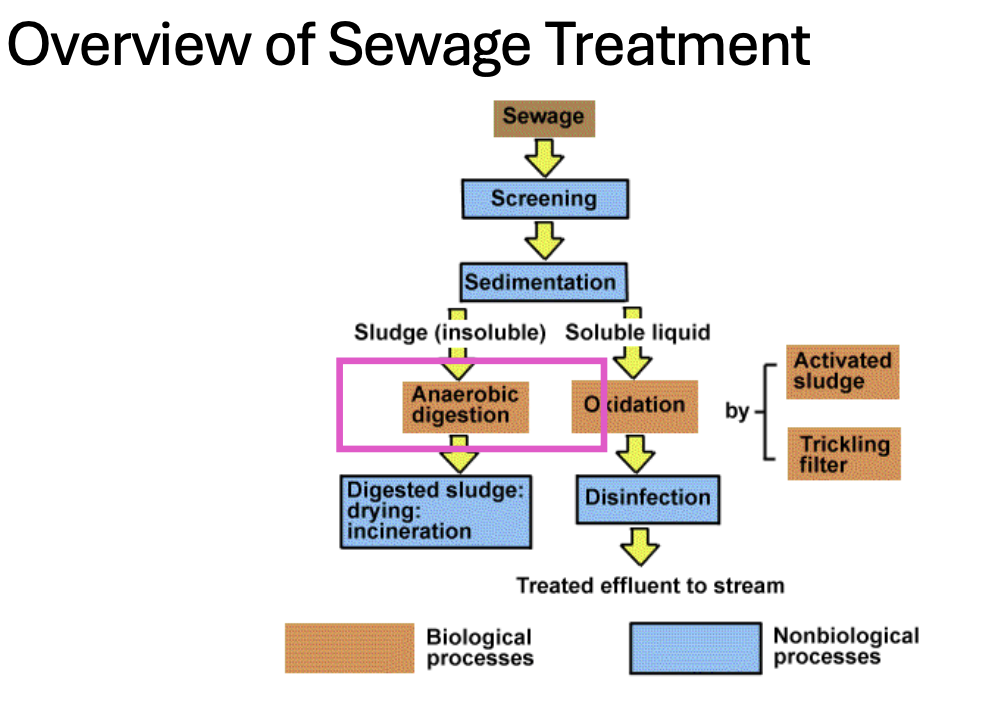
anoxic sludge digestor
Macromolecules are broken down into soluble components (monosaccharides, amino acids, fatty acids)
These are broken down into acetate, H2 , and CO2 -- substrates for methanogenic bacteria
The major products of anoxic sewage treatment are CO2 and methane
The methane is either burned off or collected for use in electric generators to heat and cool the treatment plant
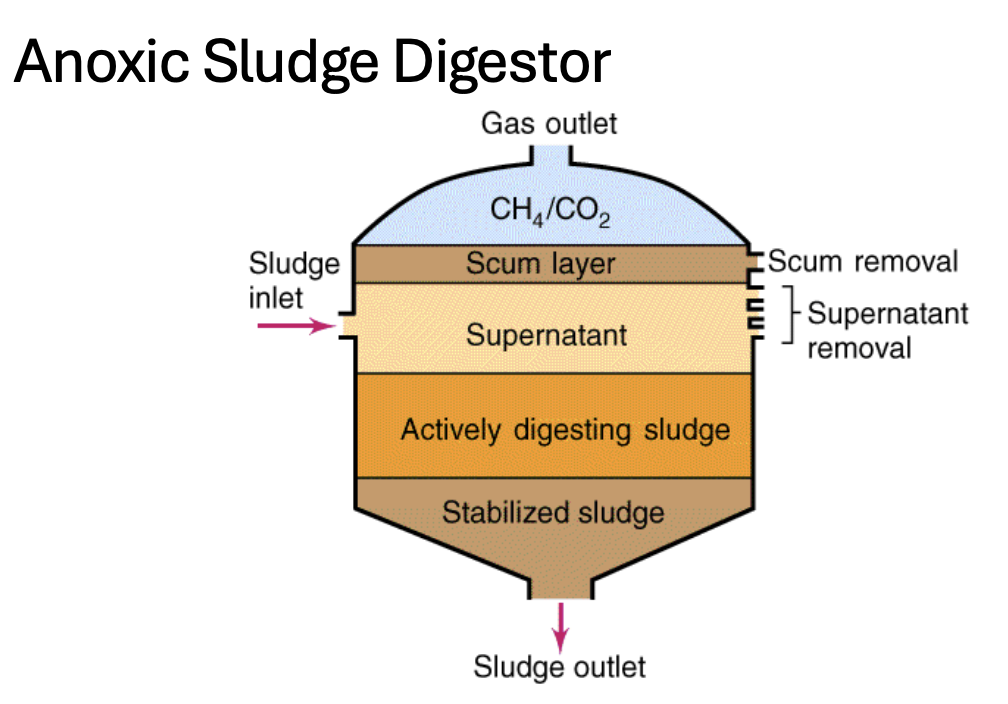
aerobic sewage treatment
Trickling filter method
The wastewater is sprayed onto a 2m deep bed of crushed rocks
As the liquid slowly trickles through the bed the organic matter adsorbs to the rocks allowing for microbial growth on the surface
The microbes mineralize the organic matter to CO2 , NH4 , nitrate, sulfate, and phosphate
Activated sludge method
The wastewater is mixed and aerated in a large tank
Slime forming bacteria (Zoogloea ramigera for example) grow and form flocs (slime encased microcolonies)
The flocs attract protozoa, other small animals, and some bacteria and fungi
The effluent containing the flocs is pumped to a clarifier where the flocs settle. Some is returned to the incubator to serve as an innoculum. The rest is sent to a sludge digestor
→ The wastewater spends only 5-10 hours in an activated sludge tank, not enough time for complete oxidation of organic materials
→ Adsorption to the floc is the primary means of reducing BOD in the liquid. Main BOD reduction occurs after transfer of the floc to the sludge digestor
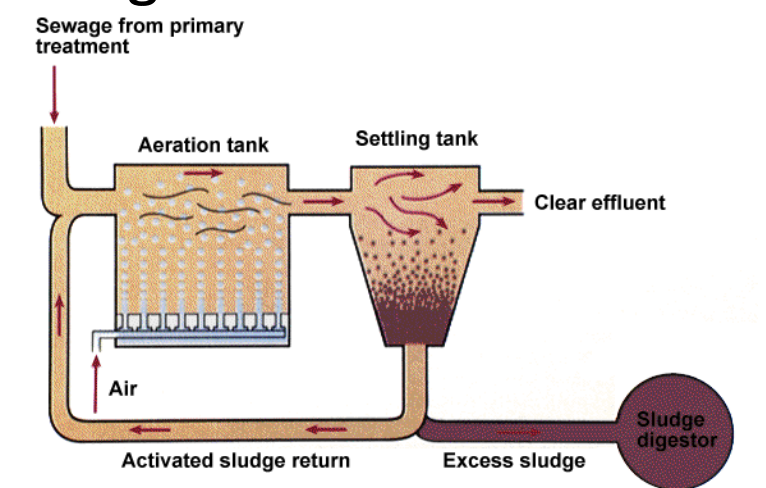
trickling filter method (aerobic sewage)
The wastewater is sprayed onto a 2m deep bed of crushed rocks
As the liquid slowly trickles through the bed the organic matter adsorbs to the rocks allowing for microbial growth on the surface
The microbes mineralize the organic matter to CO2 , NH4 , nitrate, sulfate, and phosphate
activated sludge method (aerobic sewage)
The wastewater is mixed and aerated in a large tank
Slime forming bacteria (Zoogloea ramigera for example) grow and form flocs (slime encased microcolonies)
The flocs attract protozoa, other small animals, and some bacteria and fungi
The effluent containing the flocs is pumped to a clarifier where the flocs settle. Some is returned to the incubator to serve as an innoculum. The rest is sent to a sludge digestor
these systems are:
Energy intensive
Remove nitrogen from the water cycle (and release it in the form of N2O, contributing to global warming)
Rarely produce much, if any, potable water
Thermophilic sludge digestion
adding heat to the anaerobic digestion step
Pros: doubles or triples energy recovery by producing more biogas
Cons: more nutrients are released, complicating tertiary treatment
microbial hacks to wastewater treatment
The digestion of sludge (the solids) is carried out by microbes – we can tune which microbes are there
Develop microbial strategies to make treatment more efficient
microbial circular economy
Highlighting the role of microbes in the circular economy
→ Reduce, reuse, recycle at a microbial scale
circular economy
The circular economy is a model of production and consumption, which involves sharing, leasing, reusing, repairing, refurbishing and recycling existing materials and products as long as possible. In this way, the life cycle of products is extended.